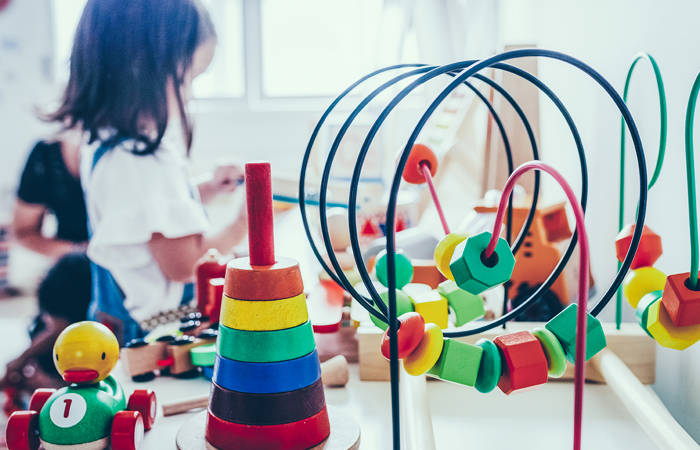Like what you see?
Sign up to receive more free parenting advice.
Thank you for subscribing to our newsletter!
Child Development

Credit: iStock.com/shapecharge
Experts are calling for a renewed focus on the ability to concentrate and stay focused, particularly for children.
Our attention and time are officially a commodity.
Technology companies aim to reach through our screens to divert our attention from whatever task we are attempting to focus on, to instead look at what they want us to.
Human ability to 'pay attention' has become a currency, as being able to focus is linked to our productivity and therefore value of labourJocelyn Brewer, a psychologist and cyberpsychology researcher and founder of Digital Nutrition
“Increasingly, there is a sense of ‘attention hijacking’ and issues in which technology has further created an ‘attention economy’, where companies vie for our attention.”
This constant split in our focus is making us adults feel like expert multitaskers.
However, research conducted by Standford University found that those who multitask were less productive than those who focused on a single task at a time.
They also found that those who were easily distracted by electronic notifications struggled to concentrate, recall information or switch from one task to the other.
If this is what’s happening to adults, what’s happening to our children’s rapidly forming brains?
“Children’s brains are undergoing a range of complex developmental processes and these are foundational for building the cognitive ability to attend to information and then use their working memory to hold onto that information to then apply it,” explains Jocelyn Brewer a psychologist and cyberpsychology researcher and founder of Digital Nutrition.
“Digital activities provide complex sensory stimulus that can divert a child’s cognitive resources and force them to multitask which can interfere with a child’s success in focus, concentration and completion of activities.”
An essential skill for the 21st Century
Nir Eyal, author of Indistractable: How to Control Your Attention and Choose Your Life says one of the greatest skills parents can teach their children is to be indistractable.
“The world is a more distracting place and if you are not prepared to deal with all the distractions then your attention and time may be manipulated by others in ways you may later regret,” he explains.
“It’s important to teach children how to manage their attention and time that best serves their interests.”
The Gonski Institute for Education has developed a series of reports titled Growing Up Digital.
It’s first report, released in 2020, focused on the views of Australian teachers and principals on how digital technologies are impacting the learning and wellbeing of Australian children.
They found that 84 per cent of educators believe that while digital technologies are a helpful teaching tool, they are a growing distraction in the learning environment.
They also believe that the number of children with psychological, social and behavioural challenges has increased in the last three to five years and points the finger at screen-time use.
Educators found that empathy in students has decreased, as well as physical activity.
More than half of the respondents observed a decline in students’ overall readiness to learn and almost 80 per cent believe that students’ ability to focus on educational tasks has decreased.
The second research report, released in 2021, focused on the perceptions of parents, grandparents and carers.
They found that over 80 per cent of parents believe their children are negatively distracted by digital technology.
The negative effects of digital technology on a child’s attention span came in as the second most significant concern expressed by parents. First, was the impact on a child’s physical activity levels and third was their time for and interest in playing.
Both Eyal and Brewer caution parents not to put all the blame on the devices, but take a deeper look at what children are engaging with when using screens.
“In moderation, age-appropriate screen-time is perfectly fine – it’s more how children use it and what’s the purpose of that particular screen-time,” Eyal says.
“For example, if they are using their device to video call their grandparents versus mindlessly watching and flicking through YouTube shows.”
“There are even some educational apps and games that may even support children to develop their concentration skills,” Brewer adds.
For example, a US study found that children who viewed educational television before the age of three didn’t demonstrate attentional problems five years later.
However, viewing either violent or non-violent entertainment television before the age of three was associated with attentional problems later on.
How can parents help?
For our children to thrive in an attention-grabbing digital world, learning how to have autonomy over their attention is the key.
Eyal highlights parents need to, not only role model their ability to be indistractable, but also ensure the time children spend on screens has an intent, rather than being used for pacification.
Brewer identifies four strategies parents can use to help support their child.
The first is valuing mono-tasking.
“Doing one task or activity at a time is the key,” she says.
“This might mean that parents need to take longer to do one task with their child, while they’re still learning tasks like putting on their shoes.”
The second is providing children with the opportunity for free play.
“We need to give children time and space to run around, climb and explore in open environments in which they can develop healthy risk-taking skills and explore their limits,” Brewer explains.
The third strategy is to recognise and acknowledge that there are healthy levels of inattention in children, like getting distracted by a toy or wanting to finish a drawing before eating dinner.
“Expecting children to be free from distraction isn’t reasonable, healthy or realistic,” she says.
“Adults struggle with attentional issues, so children with developing brains will too.”
Finally, Brewer says it’s all about balance.
“The key is that online screen-based activities are in balance with other important daily activities like good quality and an appropriate quantity of sleep, meeting the recommended guidelines on physical activity and healthy nutrition.”
Nir Eyal’s four-staged approach for parents and their children to be indisctractable:
- Internal triggers: Understand the emotional triggers that drive you to being distracted, then deal with those triggers in a healthy way, instead of reaching for the devices.
- Identify your values: Identify what you or your child values, such as spending time with family or going for walks, and prioritise those over aimless scrolling.
- Remove external triggers: no pings, no dings and no rings – turn off the noisy and flashy temptations for distraction.
- Pacts: giving older children autonomy to decide time spent on a device (which means time taken away from activities they value) can be a great step to empowering them with becoming indistractable.







